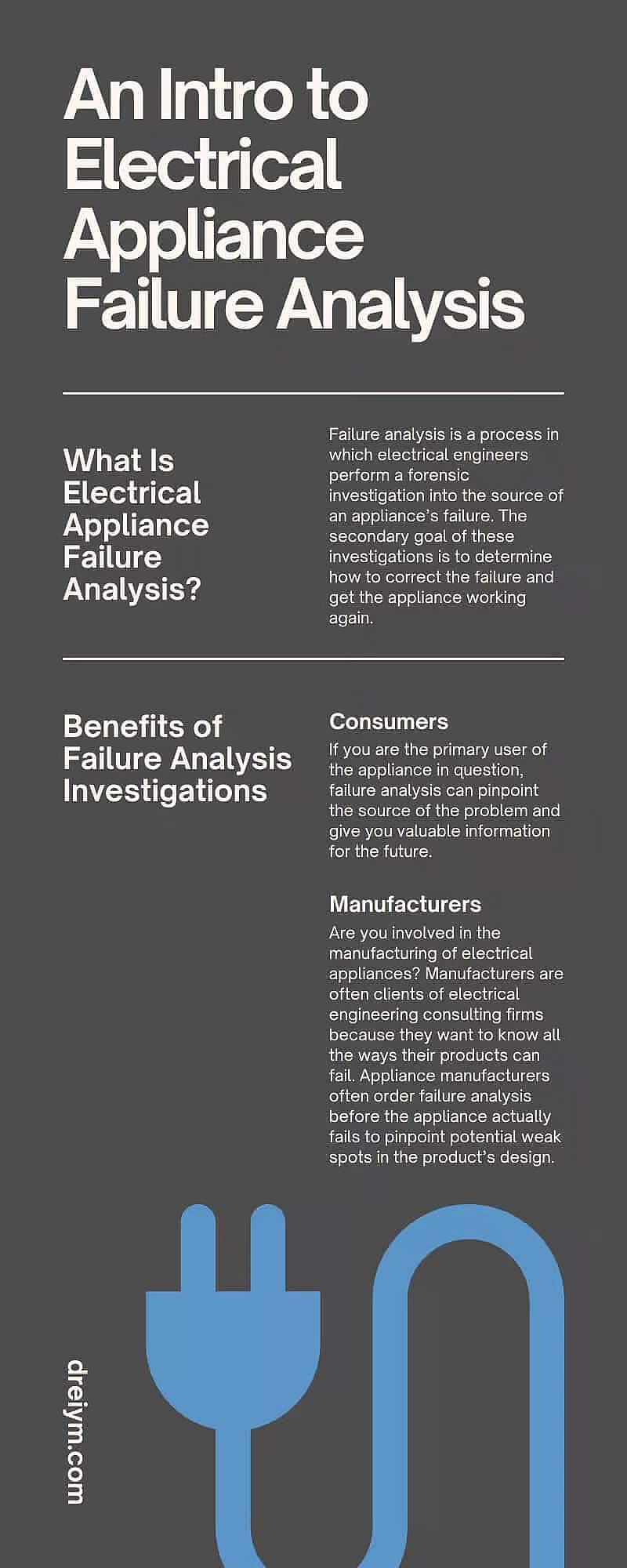An Intro to Electrical Appliance Failure Analysis
One of the many services that electrical engineers perform is appliance failure analysis or a forensic investigation into how and why an appliance stops working. Appliances fail for a variety of reasons, from faulty components to an overload in the electrical system. Failure analysis utilizes different testing methods to pinpoint the source of the problem.
Dreiym Engineering employs a team of experienced and detail-oriented electrical engineers who perform these failure analysis investigations. With our intro to electrical appliance failure analysis and what it entails, we hope to further educate you about the benefits of this valuable service.
What Is Electrical Appliance Failure Analysis?
Failure analysis is a process in which electrical engineers perform a forensic investigation into the source of an appliance’s failure. The secondary goal of these investigations is to determine how to correct the failure and get the appliance working again.
Electrical appliance failure analysis investigations benefit the users of those appliances as they learn more about how the appliance is supposed to function. Appliance manufacturers also have much to gain from failure analysis, as the investigations provide information that can improve future product designs.
Benefits of Failure Analysis Investigations
Learning the cause of an appliance’s failure can help you by providing scientifically-supported evidence of how the appliance failed.
Consumers
If you are the primary user of the appliance in question, failure analysis can pinpoint the source of the problem and give you valuable information for the future. Let’s say your washing machine stops working, and a failure analysis investigation finds a short in your electrical system. With this information, you can call an electrician to fix any wiring problems, which can prevent failures in the future.
Manufacturers
Are you involved in the manufacturing of electrical appliances? Manufacturers are often clients of electrical engineering consulting firms because they want to know all the ways their products can fail.
Appliance manufacturers often order failure analysis before the appliance actually fails to pinpoint potential weak spots in the product’s design. Because errors in design so often cause appliance failures, manufacturers want to prevent those failures before they occur. Plus, recreating the conditions under which an appliance failed can be costly and time-consuming.
Common Methods for Failure Analysis
When you contact an electrical engineer to perform an appliance failure analysis, they may use a variety of investigative techniques to find answers. Let’s look at a few common methodologies for these investigations.
Failure Modes and Effects Analysis (FMEA)
Manufacturers developing new electrical appliances want to know all the potential ways their products can fail. FMEA, as its name implies, qualitatively examines potential modes (or causes) of appliance failure and the effects they can produce.
Engineers separate modes of failure into two categories: predictable and unpredictable. During the FMEA process, engineers test a variety of predictable modes of failure and measure their effects. The FMEA ranking scales include the occurrence and severity of the failure (or effect) and the probability that the failure will occur.
Fault Tree Analysis (FTA)
If an electrical appliance has already failed, engineers may use a fault tree to visually represent the failure itself and all its potential sources. The mode or cause of the failure is represented by the top of the tree, with all potential causes branched out at the bottom.
With failure tree analysis, engineers performing the investigation prioritize logic-based cause-and-effect pairings. The tree usually consists of binary conditions (“and”/“or”) and only the most relevant events that could have led to the failure.
Hazard and Operability Analysis (HAZOP)
This failure analysis method does not provide an overall picture of the appliance’s reliability. Instead, it focuses more narrowly on potential failures that pose a risk to people, animals, or property. Analysts break down complex appliance designs into small, manageable blocks, then analyze each block individually.
When an engineer creates a HAZOP report, they identify all potential safety hazards and evaluate each individually. These reports often include recommendations for mitigative actions in the event of a dangerous appliance failure.
Action Error Analysis (AEA)
Sometimes, an appliance fails due to the error of the person operating it. Action error analysis aims to identify exactly which human errors will likely lead to appliance failure.
In practice, action error analysis implementation is remarkably similar to FMEA. Engineers familiarize themselves with the appliance in question, test a variety of action errors, and document their consequences and risk levels.
Failure Mode Effects Criticality Analysis (FMECA)
If your consulting electrical engineer performed FMEA, they might follow up with a criticality analysis. This round of analysis aims to categorize appliance failures by the severity of their consequences. Severity classifications are as follows:
- Category 4: Minor or negligible risk of injury, usually simple appliance reliability concerns
- Category 3: Marginal risk of minor injury or property damage
- Category 2: Critical risk of severe injury or property damage
- Category 1: Catastrophic risk of death or severe system malfunctions
Engineers performing FMECA rank potential appliance failures by their severity classification and the probability that the failure will occur.
Event Tree Analysis (ETA)
This method of appliance failure analysis doesn’t only document failures—it also documents successes. In event tree analysis, engineers use Boolean logic to set up a tree of events from the bottom up.
Boolean logic incorporates “truth values” that represent one of two outcomes. In computing, those values are “true” and “false,” while in failure analysis, those outcomes are categorized into failures and successes. For each event (or potential failure) tested, engineers note the outcome as either a success or failure.
Are you experiencing a failure in one or more of your electrical appliances? Are you an appliance manufacturer who wishes to eliminate hazards from new product designs? Electrical appliance failure analysis can give you the answers you need.
Dreiym Engineering’s introduction to different failure analysis methodologies provides a more detailed picture of how our engineers compile analysis reports and provide reliable answers regarding the failure’s source. If you need a thorough failure analysis performed on one or more of your appliances, get in contact with Dreiym today.













































